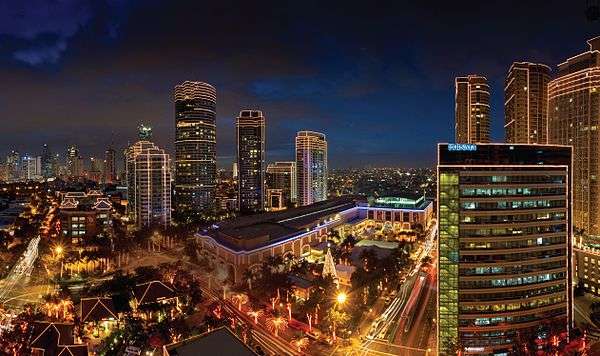Telecommunications in the Philippines
Telecommunications in the Philippines are well-developed due to the presence of modern infrastructure facilities. The industry was deregulated in 1995, leading to the creation of many telecommunication service providers for mobile, fixed-line, Internet and other services.
| Republic of the Philippines |
|---|
 |
|
Facts and figures
Telephones
- Telephones - main lines in use
- 6.782 million (2011)
- 9 international gateways; satellite earth stations - 3 Intelsat (1 Indian Ocean and 2 Pacific Ocean); submarine cables to Hong Kong, Guam, Singapore, Taiwan, and Japan
globe,tm,sun,tnt,and smart duddy.
Mobile
- Mobile prefixes used
- Numbers are coded base on network providers ranging from 0800 to 0999,[2] and international code for Philippines replace the zero to make an international call to the Philippines that would make it +63800 to +63999
Radio and Television
- Radio broadcast stations
- AM 369, FM 583, shortwave 5 (2003) For list of radio stations in the Philippines, see List of radio stations in the Philippines.
- Radios
- Main article: Radio in the Philippines
- 11.5 million (1997)
- Television broadcast stations
- 233 + 1373 CATV networks For list of television stations in the Philippines, see List of television stations in the Philippines.
- Televisions
- Main article: Television in the Philippines
- 3.7 million (1997)
Internet
- Main article: Internet in the Philippines
- Internet Service Providers (ISPs)
- 320 (2011)
- Internet Users
- 30 Million (2011)
- Country code (Top level domain)
-
- .ph and .com.ph
Area codes
Republic acts affecting telecommunications
- August 10, 1963: Republic Act No. 3846, An act providing for the regulation of radio stations and radio communications in the Philippine Islands, and for other purposes.
- December 21, 1989: Republic Act No. 6849, An act providing for the installation, operation and maintenance of public telephones in each and every municipality in the Philippines, appropriating funds therefor and for other purposes.
- March 1, 1995: Republic Act No. 7925, An act to promote and govern the development of Philippine telecommunications and the delivery of public telecommunications services.
- 2016: Republic Act No. 10844, An Act Creating the Department of Information And Communications Technology (DICT), defining its powers and functions appropriating funds thereof, and for other purposes.
SMS
SMS services are very common in the Philippines, from news briefs to multimedia services. Civilian logistical communication through SMS was an important part of the EDSA II revolt in 2001 that overthrew the government of President Joseph Estrada.[3]
Calling to the Philippines
A lot of Filipinos work outside of their country and they keep contact with their families back home using calling cards to the Philippines because those are cheaper than direct calling. Some people use e-mail or instant messaging, but the preferred method is still the phone.
Telecommunications regulatory environment in the Philippines
LIRNEasia's Telecommunications Regulatory Environment (TRE) index, which summarizes stakeholders’ perception on certain TRE dimensions, provides insight into how conducive the environment is for further development and progress. The most recent survey was conducted in July 2008 in eight Asian countries, including Bangladesh, India, Indonesia, Sri Lanka, Maldives, Pakistan, Thailand, and the Philippines. The tool measured seven dimensions: i) market entry; ii) access to scarce resources; iii) interconnection; iv) tariff regulation; v) anti-competitive practices; and vi) universal services; vii) quality of service, for the fixed, mobile and broadband sectors.


